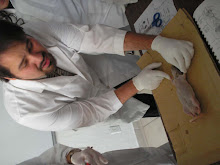Today´s class topic was: VIRUSES.
A virus has no cell which means that the virus is not alive. Viruses can have DNA or RNA, based in this, scientists classify them. When it has RNA are called retroviruses and are very harmful. Other components of a virus are:
-Proteins: Is a coat that protects the nucleic acid.
-Envelope: Made of carbs and is kind of mucous or sticky.
-Spikes: Located between the protein coat and the envelope. Spikes and the envelope of carbs work together in order to stick into other cell.
-Projections: To get stock to other cell. Have an appearance of little legs.
A virus floats inside the body of the organism in which it is (chicken, cow, human, etc.) until something stops it, so it attaches to that thing, in this case a cell for getting able to duplicate.
Something important to know is that a virus of other organism can affect a human, for example, a chicken virus can´t affect a human it just affects chickens.
There are 2 ways or forms of viruses to duplicate: LYTHIC CYCLE and LYSOGENIC CYCLE.
LYTHIC CYCLE: Lythic means destruction. It destroys the cell.
Steps:
1.- Virus attaches to the cell.
2.- It inserts DNA.
3.- The DNA gets to the nucleus. (Ehen the virus DNA gets to the nucleus, the cell DNA stops working, it is like if it deactivated the cell DNA).
4.- The cell is HIJACKED.
5.- It gets out (Inside the cell the viruses duplicates, and duplicates, and duplicates… until the cell its full of viruses and explodes, there is when each of the viruses gets to infect the nearest cell).
LYSOGENIC CYCLE: it can be familiarized as SPY CYCLE*.
Steps:
1.- The virus gets attached to the cell.
2.- It inserts its DNA.
3.- The DNA gets to the nucleus.
Up to here the first 3 steps are the same to the lythic cycle but the next 2 change.
4.- The DNA of the virus hides in the nucleus.
5.- When mitosis of the cell happens the result is 2 cells with DNA and virus, INFECTED CELLS.
*Spy cycle is not an official name for this cycle is just an example or an easier way to understand this cycle. With SPY it means that the virus gets silently into the cell and it starts getting the cell weaker and weaker until it duplicates by the mitosis of the cell.
Some words definition we saw really fast are VIROIDS and PRIONS.
-Viroids: Are biological agents with little RNA.
-Prions: Are proteins that cause disease.
Stephanie Sotelo
